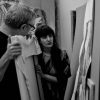From Vincent Van Gogh to Jean-Michel Basquiat, our most iconoclastic artists often seem to live within a hair’s breadth of madness. Sometimes, we even associate their greatness with the depth of their personal tribulations, giving credence to the age-old assumption that sublime works of human creativity are accompanied by profound mental suffering.
But what is the cost of that assumption?
For Ana Finel Honigman, “the correlation between self-destruction and creativity—or madness and genius—is a pervasive and deeply entrenched cultural myth.” Debunking it is a driving force in her enrollment in the School of Education’s master’s degree program in clinical mental health counseling.
Unlike many of her colleagues, Honigman entered the program without ever having formally studied psychology. She matriculated last May after almost 20 years covering fine art and fashion in London, Paris, and Berlin, writing regularly for magazines, newspapers, and peer-reviewed journals, including Artforum, The Daily Beast, The Guardian, Interview, The New York Times, and several international editions of Vogue. She curated renegade exhibitions in Dubai, Berlin, and London and lectured at major museums and universities. She styled photo shoots for fashion magazines and launched an agency for writers working with artists and fashion brands. Along the way, she earned a master’s degree and doctorate in the history of art at Oxford University.
Throughout her academic career as well as her writing practice, in the art she reviewed and the lives of the artists whose expressions she tried to decode, there ran a common, personal theme: suffering.
Honigman’s doctoral dissertation examined how contemporary artists often use images of celebrities suffering from mental illness as forms of proxy self-portraiture to explore and express private pain.
While reading for her doctorate, journalism was her outlet for talking directly to artists, practicing a form of collaborative interpretation, and developing resounding, intimate bonds with artists whom she admired. She interpreted artists’ creative expression through the lens of their personal lives, values and concerns, conducting intimate interviews that artists often told her “felt like a good therapy session.”
When she finally earned her doctorate and left the academy, she started to feel that even art criticism was still a layer away from significance. She felt the need to make a more personal and positive difference in the lives of the artists she had come to know so well.
“As someone who believes life’s primary purpose is to attempt to alleviate suffering, discussing art while distancing the artist feels irresponsible,” she said. “For me, becoming a therapist is a deeply personal pursuit that gives me joy, as well as expresses my deepest held beliefs.”
While recognizing the significant limits on a helper’s ability to heal, Honigman said she still believes counseling is the best avenue to apply her skills in making a contribution to creative individuals struggling with addiction and managing life in recovery.
“I am entering the counseling profession for the interlocked purposes of service to others and facilitating meaning in my own life,” she said.
Honigman plans to open a practice working with artists, students, writers and other creative professionals struggling with addiction and corresponding disorders or concerns, including anxiety, depression, and profession-specific challenges.
“Becoming a counselor specializing in addiction disorders and related issues within the creative community is a natural evolution of the core concerns and interests that have guided me throughout my personal and professional life,” she said.
In March 2012, she began recovery for her own alcohol use and substance-use disorders. Getting sober, through Twelve Step recovery, represented a complete transition in her life and with her creative community. While she respects the tradition of anonymity in recovery, she has used her privilege as a recognized figure in the arts community to speak out about addiction and sobriety.
“I’ve been very lucky to be in a professional and creative environment where I can be out as a recovering alcoholic and addict,” said Honigman. “Thanks to activism, celebrity voices and social media, this is an extraordinary civil rights moment in history for people suffering from my disease, and we are shattering stigma by representing ourselves and our stories in all their complexity.”
In her coursework, she is learning more about the etiological theories and nuanced terminology, but she believes that addiction is one fundamental, but multi-causal, condition, deeply interwoven into an individual’s essential identity, and it can manifest and migrate into different forms throughout someone’s life.
With the knowledge she’s acquiring at the School of Education, she plans to establish a private practice and write about how sobriety facilitates and enhances artists’ creative work, to counterbalance what she calls “the pervasive and deeply entrenched cultural myths of a positive, even necessary, correlation between self-destruction and creativity—or madness and genius.”
“Cultural myths about intoxication, substance abuse and addiction can contribute to psychological dependency by justifying substance use, distorting consequences and deterring addicted individuals from seeking treatment and achieving active sobriety,” she said.
With her deep understanding of the creative process and how artistic communities can inadvertently enable self-harm, Ana aspires to “create multiple platforms through writing, curating, speaking and therapy for artists to model culturally challenging, creatively daring, sober expression.
“I believe being a therapist and working directly with artists, fashion designers, writers and other creative people, in an integrated, humanistic practice, will help them find the best and most productive balance between living well and creating work that represents who they are while contributing to the world,” she said.

